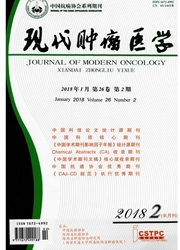

 中文摘要:
中文摘要:
目的:运用核受体辅活化子PNRC的抗Ras PTD融合多肽(PTD-PARP)研究其在乳腺癌细胞BT474中的分布、对核受体信号传导途径的影响及其抗肿瘤细胞增殖活性.方法:用多肽合成仪合成PTD-PARP、单独的PARP和PTD多肽以及FTFC标记的PTD-PARP、PARP.HPLC分析和纯化后,荧光显微镜结合流式细胞仪检测PTD-PARP、PARP在BT474细胞中的分布.虫荧光素酶报告基因检测PTD-PARP对野生型PNRC辅活化ER反式激活功能的影响.MTS、软琼脂克隆形成实验检测PTD-PARP对BT474细胞的抗增殖活性.结果:PTD-PARP能进入BT474细胞,抑制野生型PNRC辅活化ER的反式激活功能并抑制BT474细胞的增殖.结论:PNRC抗RasP DT融合多肽可通过干扰核受体途径抑制乳腺癌细胞的增殖.
 英文摘要:
英文摘要:
Objective:To study the localization, the effect on nuclear receptor signaling and the anti -proliferation activity of a PNRC - derived peptidimer, PTD - PARP, in BT474 human breast cancer cells. Methods. Five polypeptides including PTD - PARP, PAR'P alone, PTD alone and FITC - labelled PTD - PARP and PARP were synthesized by peptide synthesizer. All the polypeptides were anlysized and purified by high performance liquid chromatography (HPLC). The localization of FITC - labelled PTD - PARP and PARP in BT474 cells was detected by fluorescence microscopy and FACS. The effect of PTD - PARP on the coactiviation of wild type PNRC to the trans - activity of ER was evaluated by luciferase reporter assay. The anti - proliferation activity of PTD - PNRC in BT474 cells was detec- ted by MTS and colony formation in soft agar. Results: PTD - PARP can localized in BT474 ceils, and inhibit the co- activiation of wild type PNRC to the transactivity of ER. The peptide can inhibit the proliferation of BT474 in a dos- age - dependent manner. Conclusion: An anti - ras PTD fused PNRC - derived peptidimer can inhibit the proliferation of BT474 calls by interferring nuclear receptor signaling.
 同期刊论文项目
同期刊论文项目
 同项目期刊论文
同项目期刊论文
 期刊信息
期刊信息
